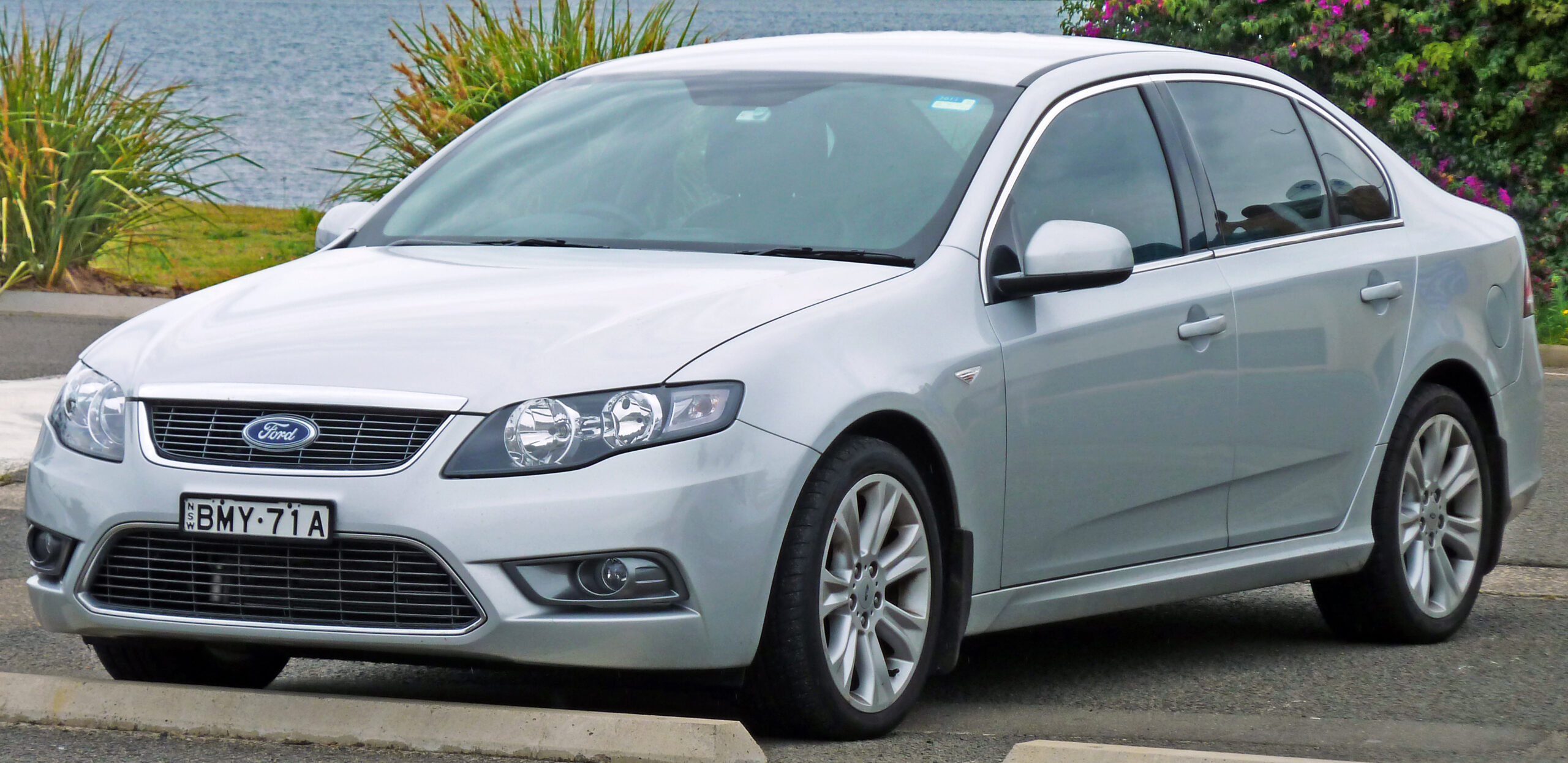The Ford Falcon: The rumble of a V8 engine echoing through suburban streets, the distinctive silhouette cutting through the Australian landscape, and the pride of ownership that came with driving something truly Australian – these memories define the Ford Falcon’s extraordinary journey through more than half a century of automotive history.
From its humble beginnings as an adapted American design to its final farewell as Australia’s last locally-manufactured car, the Falcon represents far more than mere transportation. It embodies the spirit of a nation that dared to dream big on four wheels.
The Dawn of an Australian Icon
When Ford Australia first introduced the Falcon in 1960, few could have predicted the cultural phenomenon that would unfold over the following decades.
The original concept stemmed from Ford’s desire to create a vehicle specifically tailored to Australian conditions, though the initial XK model was largely based on the American Ford Falcon. However, this wasn’t simply a case of transplanting an overseas design onto Australian soil. Engineers quickly realized that the harsh Australian environment demanded significant modifications.
The early Falcon faced immediate challenges that would shape its entire evolutionary path. Australian roads were rougher, distances were greater, and the climate was more extreme than anything the American designers had anticipated.
These factors necessitated strengthened suspension systems, improved cooling mechanisms, and more robust construction throughout. What emerged was a vehicle that, while sharing DNA with its American cousin, possessed distinctly Australian characteristics that would define it for generations.
The XK Falcon’s introduction marked the beginning of a new chapter in Australian automotive manufacturing. Unlike previous attempts to simply import overseas designs, Ford committed to developing local engineering expertise and manufacturing capabilities. This decision would prove instrumental in creating not just a car, but an entire ecosystem of Australian automotive innovation that would influence the industry for decades to come.
Engineering Excellence Down Under
Adapting to the Harsh Australian Environment
The transformation of the Falcon from an American design to a genuinely Australian vehicle required extensive engineering modifications that went far beyond superficial changes. Australian engineers discovered that the country’s unique combination of extreme heat, rough roads, and vast distances created challenges that demanded innovative solutions.
Cooling systems required complete redesigning to handle the intense Australian summer heat, particularly in the northern regions where temperatures could remain above 40 degrees Celsius for weeks at a time. The standard American radiator configurations proved inadequate, leading to the development of larger, more efficient cooling systems that became a hallmark of Australian Falcons.
Suspension systems underwent similar transformations. Australian roads, particularly in rural areas, were often unpaved and extremely rough compared to their American counterparts. This necessitated the development of stronger springs, more robust shock absorbers, and reinforced chassis components that could withstand the punishment of outback driving conditions.
The Birth of Australian Automotive Innovation
The engineering challenges faced by the Falcon program catalyzed a broader renaissance in Australian automotive innovation. Local suppliers developed specialized components that not only met the Falcon’s requirements but also found applications in other vehicles and industries. This created a ripple effect that strengthened Australia’s entire automotive sector.
Ford’s Broadmeadows facility became a center of excellence for automotive engineering, attracting talented engineers from around the world while developing local expertise. The facility’s innovations extended beyond the Falcon itself, contributing to advances in manufacturing processes, quality control systems, and engineering methodologies that influenced automotive production globally.
The Muscle Car Revolution
Performance That Matched the Landscape

The late 1960s and early 1970s marked a pivotal period in the Falcon’s evolution, as Australia embraced the muscle car era with unprecedented enthusiasm. The introduction of high-performance variants like the GT and GTHO transformed the Falcon from a practical family car into a genuine performance machine that could compete with the world’s best sports cars.
The GTHO Phase III, introduced in 1971, represented the pinnacle of Australian muscle car engineering. With its 351 cubic inch Cleveland V8 engine producing over 300 horsepower, it was capable of performance that rivaled exotic European sports cars while maintaining the practicality and reliability that Australian drivers demanded. The Phase III became legendary not just for its straight-line speed, but for its ability to handle the diverse driving conditions found across Australia.
This performance revolution coincided with Australia’s growing confidence as a nation. The Falcon’s success on racetracks and drag strips reflected a broader cultural shift toward recognizing Australian engineering excellence. No longer were Australians content to simply accept overseas designs; they demanded vehicles that reflected their own values and capabilities.
Racing Heritage and Cultural Impact
The Falcon’s racing heritage became inextricably linked with Australian motorsport culture. From the early days of touring car racing through the modern V8 Supercar era, Falcons have dominated Australian racetracks with a success rate that few other vehicles could match. This racing success translated directly into showroom appeal, as ordinary Australians could purchase vehicles that shared DNA with race-winning machines.
Bathurst, Australia’s most famous motor racing circuit, became synonymous with Falcon success. The annual October classic provided a proving ground where Falcon engineers could demonstrate their latest innovations under the most demanding conditions possible. Victories at Bathurst didn’t just represent racing success; they validated the engineering excellence that went into every Falcon produced.
Cultural Integration and Social Significance
More Than Transportation
The Falcon’s role in Australian society extended far beyond its function as a means of transportation. It became a symbol of Australian identity, representing values like reliability, practicality, and understated performance that resonated deeply with the national character. Families grew up with Falcons, passing down not just vehicles but traditions and memories that spanned generations.
In rural Australia, the Falcon earned particular respect for its ability to handle the demands of farming and station work while remaining comfortable enough for family duties. This versatility made it an essential tool for many Australian families, particularly those living outside major cities where reliable transportation could mean the difference between prosperity and hardship.
The Falcon also played a significant role in Australian popular culture, appearing in countless films, television shows, and songs that celebrated the Australian way of life. Its presence in media reflected its importance in everyday life, creating a feedback loop that reinforced its cultural significance.
Economic Impact and Industry Development
The Falcon program’s economic impact on Australia extended far beyond Ford’s own operations. The vehicle’s success supported thousands of jobs across a complex network of suppliers, dealers, and service providers that formed the backbone of Australia’s automotive industry. This ecosystem created prosperity in communities across the country, from the steel mills that provided raw materials to the small-town dealerships that served rural customers.
Local content requirements ensured that an increasing percentage of each Falcon was manufactured in Australia, supporting the development of local technical expertise and manufacturing capabilities. This policy created a virtuous cycle where increased local production led to improved quality and competitiveness, which in turn supported further investment in local capabilities.
Technological Evolution and Modern Challenges
Adapting to Changing Times
As environmental concerns grew and safety regulations became more stringent, the Falcon faced new challenges that required continuous innovation. The introduction of fuel injection systems, emission controls, and advanced safety features demanded significant engineering resources while maintaining the vehicle’s core appeal to Australian buyers.
The development of more fuel-efficient engines represented a particular challenge, as customers expected Falcon performance while accepting the need for improved fuel economy. Engineers responded with innovative solutions like multi-valve designs, variable timing systems, and eventually, turbocharged engines that delivered performance while meeting efficiency requirements.
Electronic systems became increasingly important as customer expectations evolved. Features like anti-lock braking systems, traction control, and sophisticated engine management systems required new expertise and manufacturing capabilities that pushed Ford Australia’s engineering teams to new levels of sophistication.
Market Pressures and Global Competition
The Australian automotive market became increasingly competitive as global manufacturers recognized the country’s potential. European and Japanese competitors offered alternatives that challenged the Falcon’s traditional advantages, forcing continuous improvement in quality, features, and value proposition.
Free trade agreements and reduced import tariffs intensified this competitive pressure, making it increasingly difficult to justify the costs associated with local manufacturing. Despite these challenges, Ford Australia continued investing in Falcon development, introducing new models and technologies that maintained the vehicle’s competitive position.
The Final Chapter
A Dignified Farewell
The announcement of the Falcon’s discontinuation in 2016 marked the end of an era in Australian automotive history. The final FG X series represented the culmination of over five decades of continuous development, incorporating advanced technologies and build quality that rivaled the world’s best vehicles.
The last Falcon rolled off the Broadmeadows production line on October 7, 2016, ending 56 years of continuous production and marking the conclusion of large-scale automotive manufacturing in Australia. This moment was marked not with celebration, but with a sense of profound loss as an entire industry and its associated communities faced an uncertain future.
Legacy and Lasting Impact
The Falcon’s legacy extends far beyond the vehicles themselves. The engineering expertise developed during its production continues to influence Australian industry, while the cultural impact remains evident in the strong enthusiast community that preserves and celebrates Falcon heritage. Classic Falcons have become increasingly valuable, not just as collectible vehicles but as tangible reminders of Australia’s automotive golden age.
The skills and knowledge developed during the Falcon era have found new applications in other industries, demonstrating that the program’s benefits extended beyond automotive manufacturing. Many former Ford employees have gone on to contribute to sectors like aerospace, defense, and advanced manufacturing, carrying forward the technical expertise developed during the Falcon years.
Ford Falcon’s Journey
The Ford Falcon’s journey through Australian automotive history represents more than the story of a single vehicle model. It embodies the evolution of Australian manufacturing capability, the development of national engineering expertise, and the creation of cultural icons that defined generations of Australian drivers.
From its origins as an adapted American design to its final incarnation as a world-class vehicle engineered specifically for Australian conditions, the Falcon demonstrated what could be achieved when vision, determination, and technical expertise combined with genuine understanding of local needs and preferences.
While the last Falcon may have rolled off the production line, its influence continues to resonate throughout Australian culture and industry. The lessons learned during its development, the skills acquired through its manufacture, and the memories created through its ownership represent a legacy that will endure long after the final vehicle has been driven. The Falcon proved that Australia could compete with the world’s best while remaining true to its own unique character and requirements.
Frequently Asked Questions
What made the Ford Falcon uniquely Australian compared to its American counterpart?
The Australian Falcon underwent extensive modifications to handle the country’s harsh conditions, including strengthened suspension systems for rough roads, improved cooling systems for extreme heat, and reinforced construction throughout. These changes, combined with local engineering input and manufacturing, created a vehicle that was distinctly Australian despite its American origins.
Why did Ford Australia discontinue the Falcon after such a successful run?
Ford discontinued the Falcon due to changing market conditions, including increased competition from imported vehicles, reduced government support for local manufacturing, and the high costs associated with developing new models for a relatively small market. Economic factors made it unsustainable to continue local production despite the vehicle’s cultural significance.
What was the most significant Falcon model in Australian automotive history?
The GTHO Phase III is widely considered the most significant Falcon model, representing the pinnacle of Australian muscle car engineering. Produced in 1971, it combined exceptional performance with everyday usability and became legendary for its racing success and cultural impact, establishing the template for high-performance Australian vehicles.

